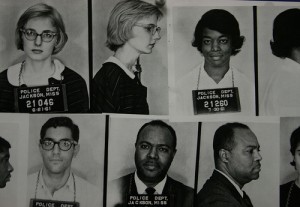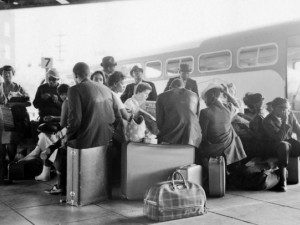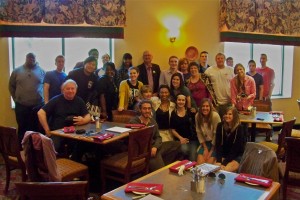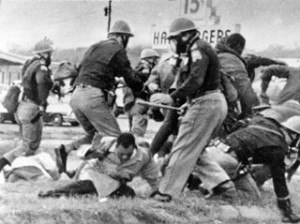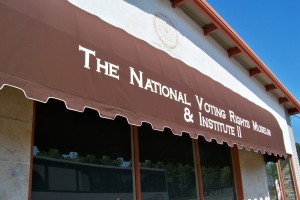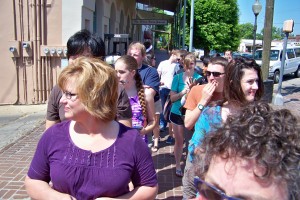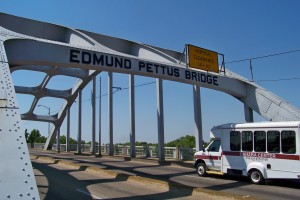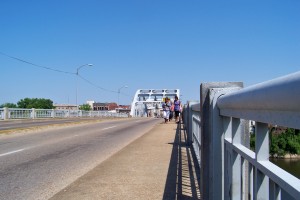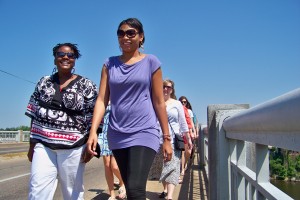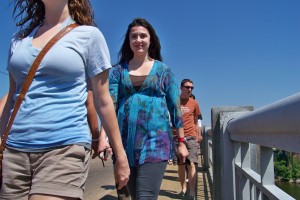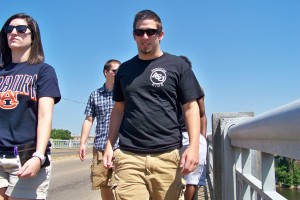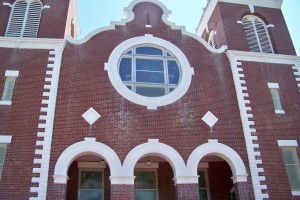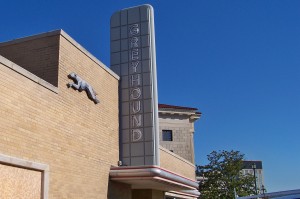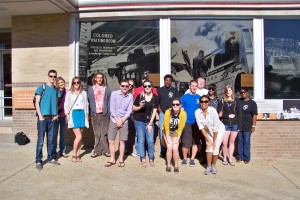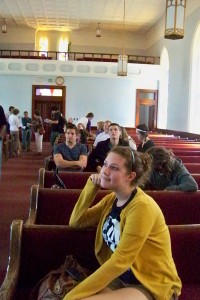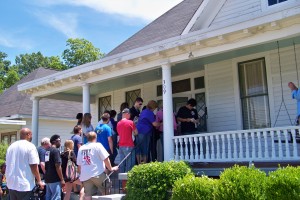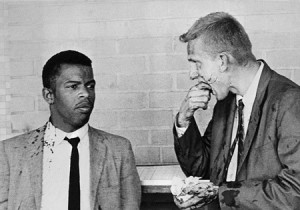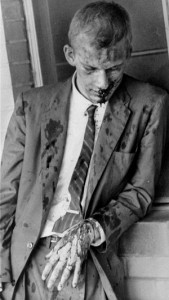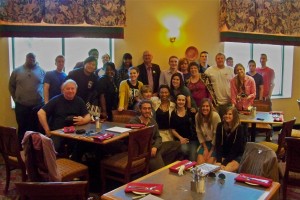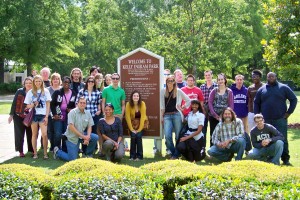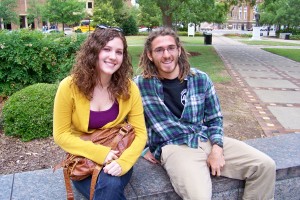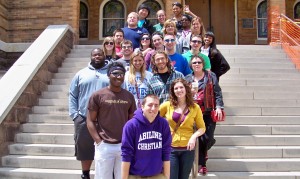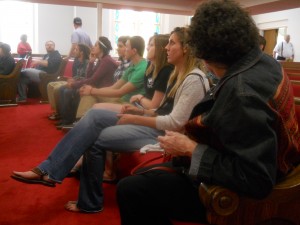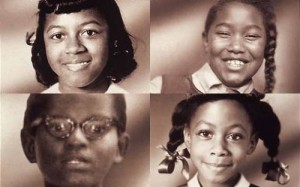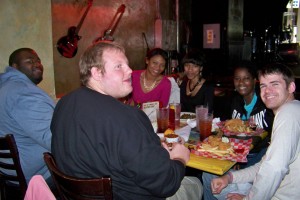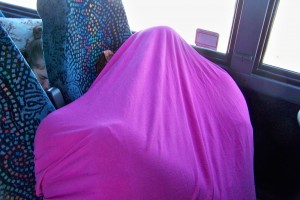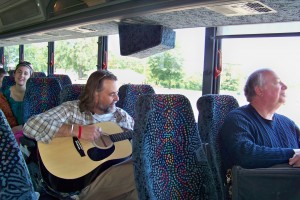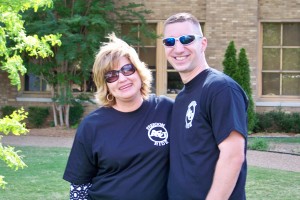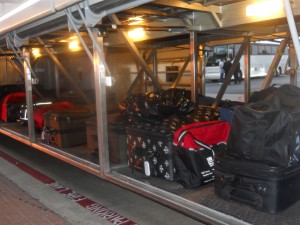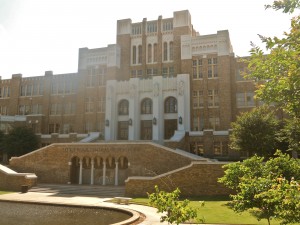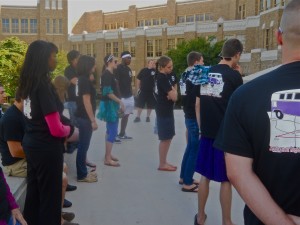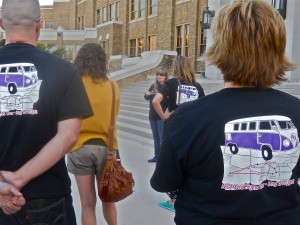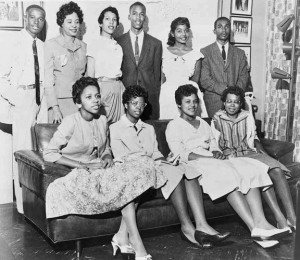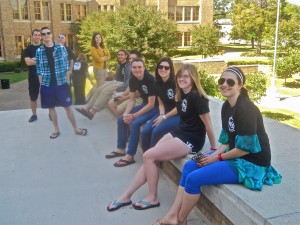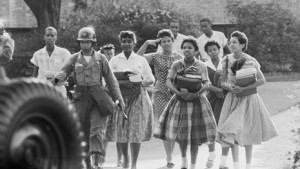Today we woke up for our second day in Montgomery, Alabama. After meeting James Zwerg the day before we felt the trip really couldn’t get any better. But guess what?
It did.
As always, our day started off with all of us eating breakfast in the hotel.

Chase

Kevin and Hart
After breakfast we drove to historic Tuskegee University, founded by Booker T. Washington and home to George Washington Carver. We stared off going to the George Washington Carver Museum on the Tuskegee campus.

George Washington Carver Museum
You know what I discovered about George W. Carver today? That he was amazing! He was a painter. A geologist. A botanist. A master teacher. He could knit, cook, and prided himself of being able to iron a crease in a lady’s skirt. He even made paints from the minerals found in the local soil so that poor people could paint their homes inexpensively. He even made the equivalent of color strips so that poor rural farmers could pick colors for the roof, walls, and trim that would create a pleasing combination. Yes, everyone knows what George W. Carver did with the peanut. In fact today I purchased his monograph “How to Grow the Peanut and 105 Ways of Preparing it for Human Consumption.” But George W. Carver was so much more than that. He was true Renaissance man.
After the museum we drove over to the Tuskegee Multicultural Center. And there our day exploded into something truly amazing.
At the Center our speaker was none other than Dr. Bernard Lafeyette. What an amazing surprise! (It wasn’t totally unexpected. We knew there was a chance we might get to meet with Dr. Lafayette, but we didn’t think it would happen. So we were really delighted to find him waiting for us.)
If you don’t know, Dr. Bernard Lafayette was everywhere during the Civil Rights movement. He, along with Diane Nash, James Bevel, and John Lewis, were leaders in the Nashville sit-in movement. Dr. Lafayette was also integral in the formation of SNCC (the Student Non-violent Coordinating Committee), considered to be the “shock troops” of the movement. Dr. Lafayette was also a Freedom Rider, on the very same bus with John Lewis and James Zwerg that was attacked in Montgomery. Dr. Lafayette was also a key leader in the voting rights drive in Alabama, with a particular focus on Selma. After Bloody Sunday, the attack on marchers on the Edmund Pettis Bridge, the work of Dr. Lafayette and others finally pushed President Johnson to pass the 1965 Voting Rights Act. Finally, Dr. Lafayette was a close associate of Martin Luther King Jr., helping, in 1968, Dr. King organize the Poor People’s Campaign. In fact, Dr. Lafayette was with Dr. King in Memphis the day before his assassination. The day of the assassination Dr. Lafayette had gone back to Washington to keep working on the Campaign and was planning to return to Memphis. Planning to return, he had kept the key to his room in the Lorraine Motel. His room was downstairs from Martin’s. But after hearing of the assassination Dr. Lafayette had no reason to return Memphis. He still has that key from the Lorraine Motel.
Currently, Dr. Lafayette is a world leader in non-violence, leading and organizing training in non-violence around the world.
So you can see why we were so excited. Two of the original Freedom Riders in as many days!
Like James Zwerg, Dr. Lafayette talked a great deal about non-violence as a lifestyle. Some within SNCC saw non-violence as a “tactic,” a means rather than an end. But like Martin Luther King Jr., Dr. Lafayette sees non-violence as a way of life, the only path to achieving peace in the world. King’s last words to Dr. Lafayette were, “Bernard, we need to find a way to institutionalize and internationalize non-violence.”
Dr. Lafayette shared a ton of stories, mainly about his work in Selma, but my favorite story of his regarding non-violence had to do with jail and ice-cream.
Dr. Lafayette told our students that one of the principles of non-violence is learning to listen to and understand the person oppressing you. As Dr. Lafayette said it, “Listening. That’s a practice of non-violence.” He also said, “Understanding. You stand under the person.” Summarizing he said, “In non-violence what we try to teach is looking through the eyes of the other person.”
The story Dr. Lafayette told to illustrate these concepts went like this. In one of the jails he was in Dr. Lafayette and the other jailed activist struck up a friendship with the jailer on the night shift. As Dr. Lafayette noted, “He was just doing his job and we were doing our job.” Initially, the activists simply entertained the night jailer with their singing. There was a lot of singing in the jails by the movement activists. As James Zwerg said the day before, “Singing was how we communicated with each other in jail. How we knew each other was okay.”
While the night jailer enjoyed the singing he was struggling with some issues related to his daughter. She was about to graduate and apply to college. But the night jailer hadn’t gone to college. So he knew nothing about college applications and admissions. But guess what? All those singing activists were college students. Maybe they could help. So the jailer asked for help. And Dr. Lafayette and the others talked to him about financial aid, the application process, letters of recommendation, etc. And each morning, after his shift, the jailer would go home and pass on the advice to his daughter.
To show his appreciation the jailer began smuggling ice-cream to the activists. To prevent outrage among the other prisoners the jailer would put the ice-cream in a mop bucket and put the mop over it. He would then push the bucket past the other cells until he got down to the activists where the ice-cream was unloaded. For Dr. Lafayette this little story captured the power of non-violence, of two people finding shared humanity in the other. Summing up the story Dr. Lafayette said, “For some in the Movement non-violence was a tactic. For us it was a way of life. Ice cream! That’s what I’m talking about!”
What an amazing experience. In our two days in Montgomery we got to be with James Zwerg and Bernard Lafayette.
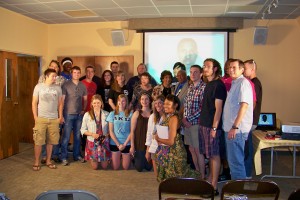
ACU Freedom Riders with Dr. Bernard Lafayette
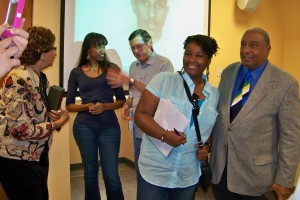
ACU Freedom Riders with Dr. Bernard Lafayette
Before our departure for lunch Dr. Lafayette concluded with this challenge to our students:
“Find an issue in life that you are willing to die for. We’re all going to die. The question is, are we going to live?”
After lunch, before leaving campus, we took a quick tour of Booker T. Washington’s house The Oaks.
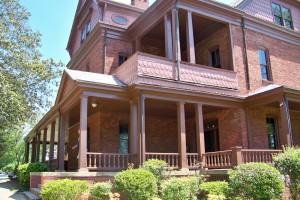
The Oaks--The Home of Booker T. Washington
One of the interesting things about The Oaks and much of the Tuskegee campus is that the bricks were made on the campus by the Tuskegee students. I joked with the students that brick-making is the next summer class we’re going to try at ACU. They weren’t amused.
We left Tuskegee and traveled back to Montgomery to visit the Southern Poverty Law Center and the Civil Rights Memorial. The SPLC is actively involved in monitoring hate groups and prosecuting hate crimes. The Memorial associated with the SPLC is oriented around 40 Martyrs of the movement. The martyrs include Emmett Till, the four girls from the 16th Avenue Church bombing in Birmingham, the Freedom Summer workers–James Chaney, Andrew Goodman, and Michael Schwerner–and Martin Luther King, Jr. Outside the SPLC there is a memorial fountain where the names of the martyrs are listed along with significant moments in Civil Rights history. It was a powerful walk through our entire Freedom Ride Tour: the Little Rock Nine, the Memphis sanitation worker’s strike, Rosa Parks, the Montgomery bus boycott, the Freedom Rides, the Birmingham riots, the bombing of 16th Avenue Church, Bloody Sunday, the shooting of Medgar Evers, the Selma-to-Montgomery Voting Rights March, the March on Washington, and the assassination of Dr. Martin Luther King.
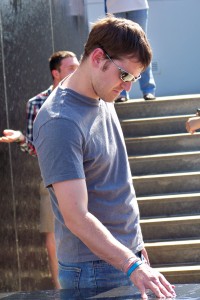
Theron at the Civil Rights Memorial
Finally, inside the SPLC, as a part of the Civil Rights Memorial, there is a Wall of Tolerance. If you’d like to add your name to the wall, with the thousands who have done so, you take the following pledge:
By placing my name on the Wall of Tolerance, I pledge to take a stand against hate, injustice and intolerance. I will work in my daily life for justice, equality and human rights – the ideals for which the Civil Rights martyrs died.

